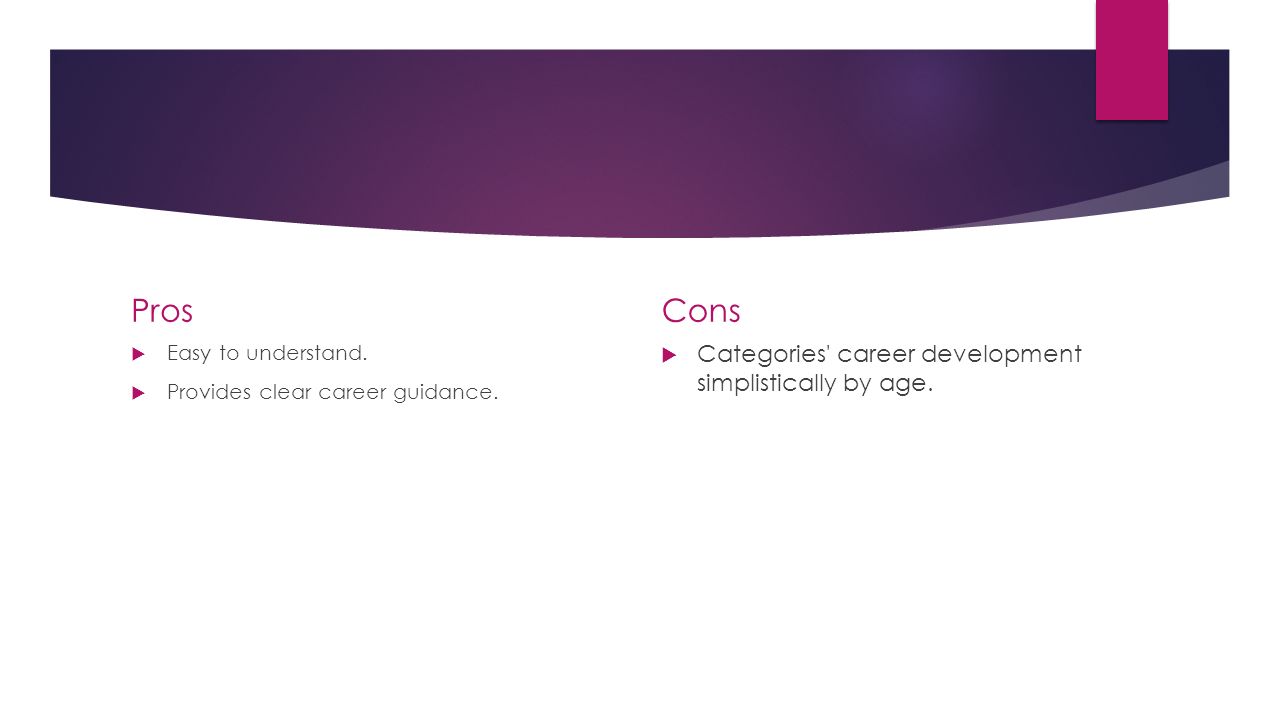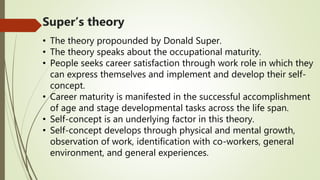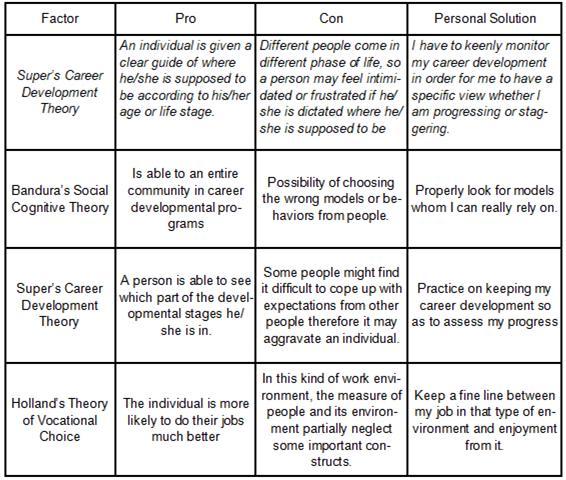Pros of Super’s Career Development Theory include its holistic view and adaptability across one’s lifespan. Cons involve its potential oversimplification and lack of focus on diverse socio-economic contexts.
Super’s Career Development Theory offers a multi-faceted approach to understanding how individuals choose and progress in their careers. It suggests that personal growth, self-concept, and life roles significantly influence occupational choices and satisfaction. Emphasizing the idea of career maturity and adaptability, this theory resonates with many, providing a robust framework for career counselors and educators.
Yet, critics argue that it may not fully accommodate the complexity of career decisions in a rapidly changing job market, and it fails to address varied cultural and social barriers individuals may face. Providing valuable insights into the path of career development, the model’s broad applicability and focus on personal development are among the aspects that have sustained its prevalence in the field of vocational psychology. [Career Development Theory.]
Introduction To Super’s Career Development Theory
Super’s Career Development Theory shines a light on the journey individuals embark on to find their professional path. Donald E. Super crafted a theory presenting career development as a lifelong process. This theory helps in understanding how personal characteristics interact with various life roles to shape a career.
Earliest Influences
The seeds of career choice and growth are often sown early in life. Super theorized that one’s abilities, interests, and personality are pivotal from a young age. Peers, family, and cultural background cast a significant impact. These elements start the career development process that continues to mature over time.
Five Life And Career Development Stages
In Super’s outlook, career development unfolds in five main stages:
- Growth: Building self-concept, from childhood to adolescence
- Exploration: Trying out different jobs, typically in the 20s
- Establishment: Gaining skills and securing a job, in the mid-20s to 40s
- Maintenance: Continuing development, from the 40s to retirement
- Decline: Gradually disengaging from work, post-retirement
Understanding these stages helps in planning one’s career and anticipating future changes.

Credit: slideplayer.com
Key Components
Let’s dive into the core parts of Super’s Career Development Theory. This framework helps us understand how careers unfold over time. Most importantly, it focuses on two huge ideas: who we are and the roles we play as life goes on. These ideas are a big deal in the world of careers. We’ll explore each part to see how they shape our work lives.
Self-concept Theory
Self-concept theory is like the engine of Super’s Theory. It says what we think about ourselves matters a lot. Our strengths, interests, and values drive our career choices. This part explains why knowing yourself leads to better career decisions. Let’s look at it in simple points:
- Personal Understanding: It’s about knowing what you like and don’t like.
- Professional Direction: This knowledge guides the types of jobs you’ll be good at.
- Growth Over Time: As you grow, your self-concept changes and so might your career path.
Life-span, Life-space Approach
The Life-Span, Life-Space Approach adds another layer. It blends who we are with our world. Think of your life as a stage with many parts. You might be a student, parent, or worker all at once. Here’s why it’s a big piece of the career puzzle:
- Multiple Roles: We play different roles at different times in our lives.
- Changes and Stages: Our careers change as we move through life’s stages.
- Role Balance: It’s important to juggle these roles well for career happiness.
Advantages Of Super’s Model
Exploring career paths can be a complex journey. Super’s Career Development Theory offers unique benefits. Let’s delve into the advantages of Super’s Model.
Holistic Perspective
Super’s Model views career development as part of life, not separate from it. This approach considers how personal experiences shape career choices. It guides individuals to understand how their hobbies, skills, and values integrate with their professional lives. Such a comprehensive view can lead to more fulfilling career decisions.
Flexibility And Adaptability
- Adapts to different life stages – Super’s Model evolves as individuals grow.
- Accounts for change – It recognizes career shifts and personal developments over time.
- Customizable paths – Users can tailor their career strategies to fit unique circumstances.
Emphasizes Life-long Growth
Career development never stops, according to Super’s Model. It highlights the idea of continuous learning and evolving in the workplace. This theory encourages individuals to seek new challenges and opportunities throughout their lives. Thus, it supports a dynamic, rather than static, view of career progress.
Critiques Of Super’s Approach
In examining Super’s Career Development Theory, we cannot ignore the various critiques. While the theory offers a comprehensive framework, it also presents certain limitations. In this section, we’ll delve into the key critiques to better understand the theory’s applicability in today’s diverse and dynamic world.
Lack Of Cultural Diversity
One of Super’s Theory’s primary critiques stems from its limited cultural perspective. Initially formulated in a Western context, the theory may not entirely reflect the career development processes of individuals from different ethnic backgrounds or societies. Let’s discuss the main points:
- Global applicability is questionable, as career progression can differ vastly across cultures.
- It misses nuances found in non-Western cultures where social and familial influences significantly impact careers.
Gender Biases
Another point of contention lies in the apparent gender biases present in Super’s work. Consider the following aspects:
- The theory was developed at a time when gender roles were more rigid, leading to an oversight of women’s career paths.
- It does not fully account for part-time work or career breaks that are common in women’s employment patterns.
Overemphasis On Linearity
Finally, Super’s Theory is often critiqued for its linear and stage-based approach to career development. Below we underline some critical views:
- Careers today are rarely linear, and often characterized by changes and transitions.
- The theory’s five life and career stages may not align with the modern-day gig economy and the non-traditional career paths many take.
Applications In Career Counseling
Applications in career counseling draw heavily on Super’s Career Development Theory. This theory provides a comprehensive framework for understanding the career development process. It aids counselors in shaping strategies for their clients. Counselors use this theory to guide individuals through their career journey, from selection to retirement.
Career Planning And Management
Super’s theory emphasizes life-long growth and adaptability. Counselors apply this aspect to help clients:
- Understand their interests and abilities.
- Relate these interests and abilities to career opportunities.
- Set realistic goals and develop action plans.
They also provide support in:
- Identifying potential career transitions.
- Enhancing skills for job market changes.
- Adapting to different life roles over time.
Educational Guidance
The theory’s applications extend into education. Counselors assist students to:
- Make informed educational choices.
- Link their courses with future careers.
- Understand how education impacts career trajectories.
In schools and universities, Super’s theory helps in developing:
- Career education programs.
- Work experience opportunities.
- Internship placements aligning with student interests.

Credit: www.slideshare.net
Super’s Theory In Modern Context
Super’s Theory in Modern Context has sparked lively debates on its applicability in today’s fast-paced, ever-changing career landscape. Donald Super’s career development theory, which emphasizes the role of self-concept in career choice and satisfaction, faces new tests in an environment marked by diversity and technology.
Relevance In Today’s Diverse Workforce
With a spotlight on diversity, the question arises: does Super’s theory resonate with the diverse workforce of the 21st century? Super’s stages of career development–growth, exploration, establishment, maintenance, and disengagement–provide a framework for understanding career progression. Yet, this progression may not align with the nonlinear and often unpredictable career paths in today’s dynamic job market.
One aspect of Super’s theory is that it appreciates individual differences in career development, which is essential in a diverse workforce. Despite this, the emphasis on linear progression may not apply to everyone, especially with the rise of gig economies and portfolio careers. It’s crucial to adapt Super’s model to reflect the fluidity of modern careers. There’s potential in tailoring the theory to support individuals across a variety of backgrounds, industries, and life experiences.
Use In Digital Career Tools
In the digital age, career development tools have blossomed online, inviting users to explore their career paths in innovative ways. Super’s theory can be woven into digital platforms, providing a structured approach to self-assessment and career planning. Its stages and the concept of career maturity can be used to develop online questionnaires, help individuals understand where they are in their career journey, and suggest steps to move forward.
Platforms can integrate Super’s ideas to create adaptive learning environments personalized to each user’s career stage. Such tools can suggest training programs, connect users with mentors, and offer advice tailored to their self-concept and career maturity level. Converting Super’s theory into digital career guidance requires an understanding of its fundamental principles and the creativity to apply them in the context of artificial intelligence and machine learning.
In conclusion, implementing Super’s career development theory into modern career tools offers structured and personalized guidance. It requires an innovative approach to bridge the gap between traditional theoretical models and the versatile digital tools of today.
Comparative Analysis
Welcome to our comparative analysis of Super’s Career Development Theory. In this section, we’ll delve into how Super’s framework sizes up against other prominent career theories. We’ll also look at the benefits and challenges of blending different approaches for a more comprehensive understanding of career development.
Super Vs. Other Career Theories
Diving into the realm of career psychology, Super’s Theory stands out for its lifespan perspective. Unlike other theories, Super views career development as a lifelong process. This stands in contrast to theories that focus solely on early life stages or particular career decisions. Super’s concept of self-concept in career development is distinctive.
| Theory | Focus | Super’s Unique Contribution |
|---|---|---|
| Holland’s Theory | Personality-job fit | Lifespan Coverage |
| Bandura’s Social Cognitive Theory | Self-efficacy and outcome expectations | Self-concept as a driver |
| Krumboltz’s Decision Theory | Learning Experiences Shaping Career Beliefs | Development stages from childhood to late adulthood |
Integrating Approaches
Weighing the pros and cons of Super’s Theory leads to the idea of combining theories for a richer analysis. This synthesis allows for a multi-dimensional view of career development. Integrating Super’s lifespan approach with other theories enriches our understanding of how individuals shape and reshape their careers over time.
- The lifespan perspective complements theories emphasizing particular life stages.
- Adapting self-concept works well with cognitive theories focused on self-efficacy.
- Stages of Super’s theory bring structure to more flexible frameworks.
- Assess unique aspects of each theory.
- Identify intersection points for integration.
- Apply a blended approach in real-world settings.
Future Directions
Super’s Career Development Theory has guided many toward understanding their career paths. Yet, today’s dynamic job landscape suggests new trails for exploration.
Updates And Revisions Needed
A modern workforce requires up-to-date theories. Changes in technology and values mean the original theory must evolve.
We must consider digital careers, remote work trends, and lifelong learning. New dimensions like the gig economy also need integration.
Super’s stages and the concept of career maturity could adapt to the current fluid career trajectories. Updates could ensure relevance for the next generation.
Research Opportunities
There is a rich terrain ahead for research within Super’s framework. Studies could focus on diverse groups and non-linear careers.
- Cultural applicability: How does the theory hold across different cultures and economies?
- Technology’s impact: How have advancements redefined career development?
- Age variations: With people working later into life, how do career stages shift?
Quantitative data on career patterns would add value. Such research might transform Super’s model into a more global guide.

Credit: slideplayer.com
Frequently Asked Questions
What Is The Pros Of Super’s Career Development Theory?
Super’s career development theory offers a holistic view of individuals’ career paths, emphasizing personal growth and change throughout life stages, aiding in effective career planning and adaptation.
What Are The Disadvantages Of Donald Super’s Theory?
Donald Super’s theory can seem rigid, overlooking non-linear career paths. It may not fully accommodate diverse life roles and modern flexible workstyles. Changes in labor markets challenge its applicability.
What Are The Negatives Of Career Development?
Career development can lead to work-life imbalance, increased stress, potential burnout, and neglect of personal relationships. Constant learning demands might also induce anxiety and financial strain due to the costs of additional education or training.
How Super’s Theory Can Help You Better Understand Your Current Career Life Stage?
Super’s theory outlines five career development stages: growth, exploration, establishment, maintenance, and disengagement. Understanding these stages helps you identify your current career phase and prepare for future transitions, ensuring continuous personal and professional growth.
Conclusion
Exploring Donald Super’s Career Development Theory provides valuable insights for individuals navigating their career paths. While it offers a multifaceted perspective, recognizing its limitations is equally important to ensure a tailored approach. Embrace this framework with an understanding of its pros and cons for a more enriched career development journey.

I’m based in the USA, Canada, Australia, and the UK—four vibrant countries with rich educational landscapes and diverse news ecosystems.
Feel free to adjust and personalize this introduction to reflect your unique voice and experiences. Happy writing! 📝✨

